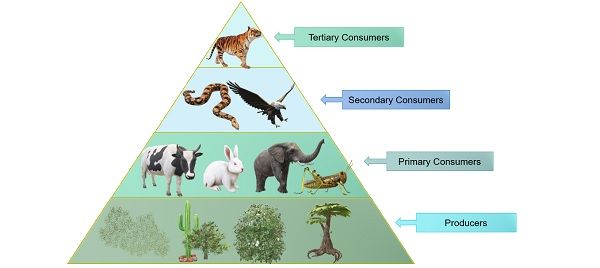
The term ‘Producers‘ is used in biology to describe the living entities that have the potential to produce food from natural elements like sunlight, carbon dioxide, water, etc. The ‘Consumers,’ on the other hand, are those living beings that rely on the producers or the other lesser consumers for their food requirements.
The producers primarily make food by the process of ‘photosynthesis’ and are so referred to as autotrophs. Consumers, on the other hand, lack the ability to photosynthesise and are classified as heterotrophs.
This implies that producers not only generate energy for themselves but also act as energy sources and suppliers to the higher organisms at the trophic level. In this section, we’ll go through the key differences between the two main stakeholders in the ecosystem: Producers and Consumers.
Content: Producers Vs Consumers
Comparison Chart
| Basis of Comparison | Producers | Consumers |
|---|---|---|
| Alternative name | Autotrophs | Heterotrophs |
| Meaning | Producers are those organisms capable of creating their own food in the form of simple sugars by using the elementary components of nature like sunlight, water, CO2 etc. | Consumers are the living organisms that are not capable of synthesising their own food instead they consume the food made by producers. |
| Examples | Plants, algae, weeds, phytoplankton etc. | Humans, birds, animals etc. |
| Mode of nutrition | Autotrophic. | Heterotrophic |
| Position in trophic level | They are at the first trophic level. | They occupy 2nd to 4th positions in the trophic level. |
| Photosynthesis | They perform photosynthesis. | They cannot perform photosynthesis. |
| Chlorophyll | They have chlorophyll to trap solar energy from sunlight. | They cannot trap solar energy as chlorophyll is absent. |
| Dependency | They are not dependent on any other organism for food. | They are dependent on the producers for energy source. |
| Energy consumption | They consume solar energy from the sun. | They consume chemical energy generated by the producers. |
| Energy production | They produce chemical energy from solar energy. | They convert the chemical energy into potential or kinetic energy. |
| Chemistry behind | They take the inorganic nutrients from nature and transform them into organic form. | They take most of the nutrients which are already in the organic state. |
| Requirement | They require carbon dioxide, water, chlorophyll, sunlight etc., for photosynthesis. | They require oxygen and chemical energy (food from producers), water etc., for their survival. |
| By-product | They utilise CO2 and give out oxygen as a by-product. | They utilise oxygen and give out carbon dioxide as a by-product. |
| Types | Photoautotrophs and chemoautotrophs | Primary consumers, secondary consumers and tertiary consumers |
Definition of Producers
The autotrophic (‘auto’= self; ‘troph’= nourishment) components of the ecosystem tend to create their own food in the form of simple sugars by using the elementary components of nature like the sunlight, water, CO2, etc., are called Producers.
The ability of producers to convert solar energy into chemical energy is the beneficial property that enables producers to nourish the other biotic components of the environment.
How do producers make their food?
The producers can make their food with the help of two biological processes:
- Photosynthesis
- Chemosynthesis
On the basis of the method used for food making; producers can be classified into two major categories:
- Photoautotrophs
- Chemoautotrophs
Photoautotrophs
‘Photo’ stands for ‘light’, and ‘auto’ means ‘self’. They are living biological entities that use light energy to synthesise organic matter from the naturally available inorganic nutrients.
They possess the ability to transform the sun’s solar energy into chemical energy, i.e. the organic sugars.
Photosynthesis: “Photosynthesis is a natural process that aids in the manufacture of food from the natural components. By fixing solar energy, complex inorganic compounds are converted into simpler organic ones during photosynthesis”.
Photoautotrophs perform a series of chemical reactions in the presence of light under the process of photosynthesis.
Chemical reaction occurring in producers
Note- The photoautotrophs have a green colour pigment called chlorophyll. This pigment is responsible for trapping the light (photons) from the sunlight, which is essential for the light reaction.
Examples of Photoautotrophs
All the living organisms that are green in colour due to the presence of chlorophyll are classified as photoautotrophs.
- Phytoplankton: They serve as prime producers in the freshwater or marine ecosystems. They are found abundantly in the water bodies (about one and a quarter crores per sq. foot).
Example: Dinoflagellates, diatoms, etc.
- Algae: The algae are unicellular or multicellular producers for terrestrial as well as aquatic ecosystems. They predominantly utilise the organic pollutants as for carbon source, ultimately cleaning the water bodies.
Example: Cyanobacteria, also known as blue-green algae.
- Green Plants: All the green plants undergo the photosynthetic reaction. They use carbon dioxide from the air as a carbon source, water from the ground, photons from sunlight to manufacture carbohydrates(glucose). Oxygen is released as a by-product of this reaction.
Example: Peepal, Banyan, etc.
Chemoautotrophs
‘Chemo‘ is for ‘chemical‘. These organisms use the chemical substance from nature as their nutrient intake and convert them into complex organic matter.
They perform chemosynthesis instead of photosynthesis.
Chemosynthesis: The process of combining two or more basic and simpler chemical components to create a complex substance is called “Chemosynthesis“.
The chemoautotrophs use the inorganic chemical derivatives of hydrogen, sulphur, iron, etc., for producing organic carbohydrates.
Examples of Chemoautotrophs
Some of the bacterial species like sulphur-oxidising bacteria, methanogenic archaea, epsilon proteobacteria, iron-oxidising bacteria, etc., are typical examples of chemoautotrophs.
Definition of Consumers
Consumers show the heterotrophic mode of nutrition due to their disability of synthesising their own food. For this reason, they are often referred to as ‘heterotrophs’.
Due to the lack of chlorophyll, consumers are unable to perform photosynthesis. As a result, they are completely reliant on producers or other lower-level consumers to comply with their energy needs.
The higher trophic levels in the food chain are occupied by consumers. They are classed as follows based on their position in the trophic level:
- Primary Consumers: This category includes organisms that are completely and exclusively reliant on producers for their nourishment. They occupy the second position in the food chain.
Example: Herbivores like grasshoppers, beetles, cows, rabbits, goats, horses, deer etc.
- Secondary Consumers: They basically are the higher organisms that feed on both producers as well as consumers. These are the omnivores that are at the third trophic level.
Example: Snakes, rats, crabs, lizards, birds, frogs, etc.
- Tertiary Consumers: These consumers rely on primary and secondary consumers along with the producers for food requirements. They are at the fourth trophic level. They can be omnivores or carnivore organisms.
Example: Lion, tiger, panther, whales, flounders etc.
Key Differences Between Producers and Consumers
- Producers can synthesise their own food with the help of inorganic components, but, consumers are unable to do so because they are unable to use those elements directly for food production.
- Producers undertake the photosynthetic reaction by utilising naturally occurring resources such as sunlight, water, carbon dioxide, and so on, whereas consumers are unable to do so since they lack the ability to use these resources.
- The majority of the producers have chlorophyll pigment, which traps photons from the sun and drives photosynthesis. The photons cannot be absorbed by the consumers because they lack chlorophyll.
- During photosynthesis, producers can convert solar energy into chemical energy. Consumers, on the other hand, convert chemical energy into potential or kinetic energy.
- Producers turn inorganic nutrients into organic sugars, which are essentially carbs like glucose. Producers or lower consumers are the main sources of organic nutrients for consumers.
- Carbon dioxide is essential for producers as it serves as a source of carbon for photosynthesis, while oxygen is important for consumers for cellular respiration.
- The producers are independent bodies as they do not rely on the other creature for food. In contrast, consumers are dependent bodies as they need other living organisms to meet their food requirements.
Conclusion
The ecosystem works on the principles of coordination, dependency and collaboration among the biotic and abiotic components. Similarly, the harmony between producers and consumers is an essential component for the smooth functioning of the ecosystem. Therefore, both of them are equally important elements of the environment.

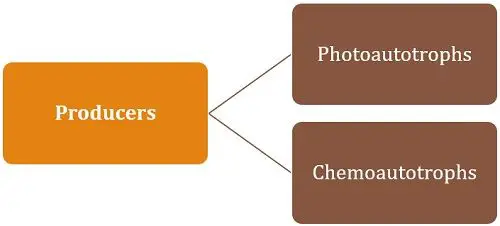

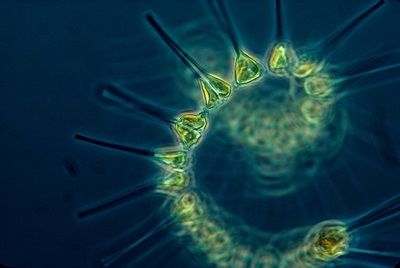
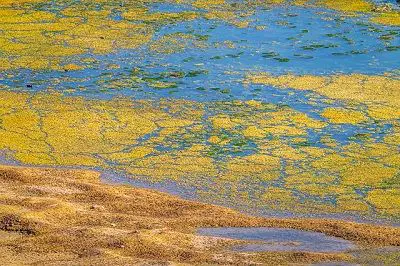

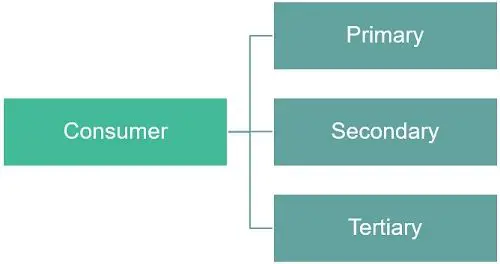
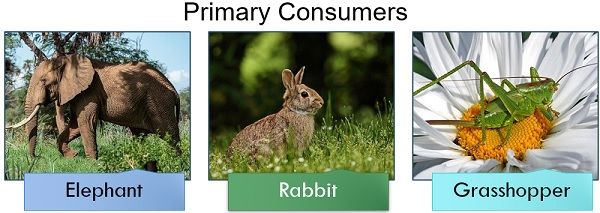
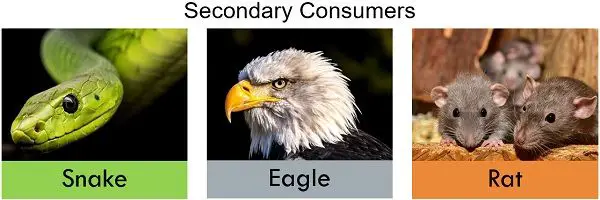
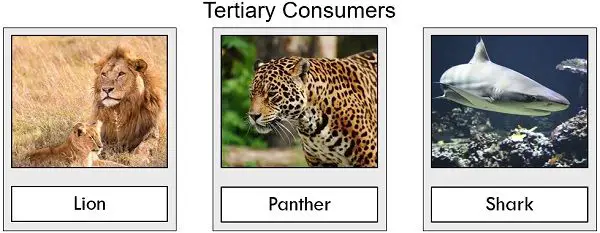
Leave a Reply